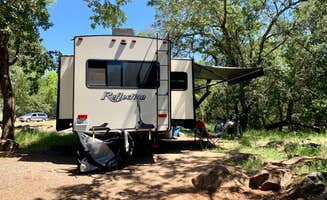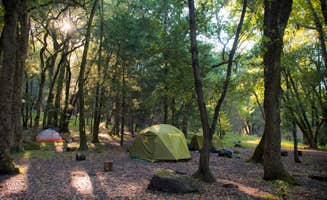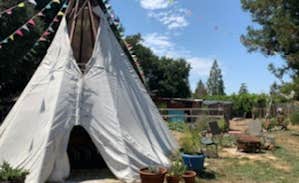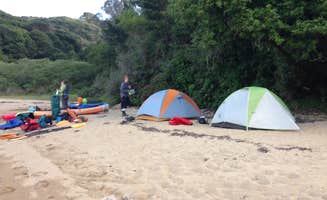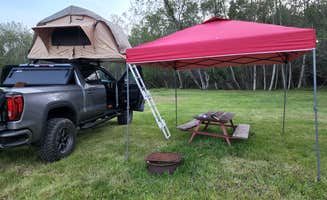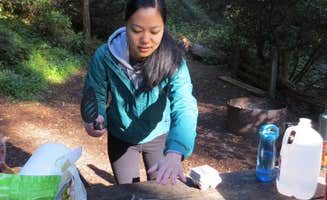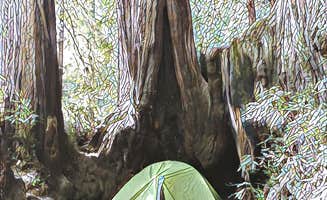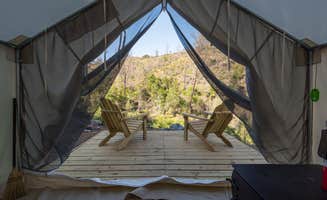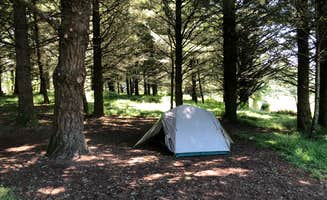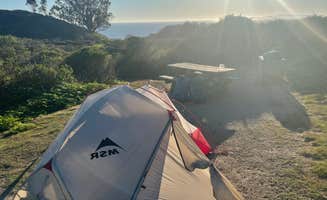Camping near Petaluma, California offers a diverse natural landscape with elevations ranging from sea level at coastal sites to over 2,000 feet at inland parks like Sugarloaf Ridge. The region experiences moderate temperatures with summer highs averaging 82°F and winter lows rarely dropping below 40°F, creating favorable year-round camping conditions. Coastal sites often experience morning fog that burns off by midday, while inland locations maintain drier conditions.
What to Do
Hiking diverse terrain: At Samuel P. Taylor State Park Campground, trails wind through redwood groves with convenient access to longer routes. "From the campground you can easily hike 20 miles around the park. There are a handful of great loop options and a few great out and backs too," notes Michael I. The park offers multiple trail difficulties for various experience levels.
Beach activities: At Doran Regional Park, the protected cove provides calm waters suitable for families. "Doran Beach is great, especially during the summer for kids because it's a well protected cove and the waves don't usually get very high," shares Justin W. The wide, flat beach extends for over a mile, perfect for walking, surfing, and fishing.
Astronomy and stargazing: Sugarloaf Ridge State Park hosts the Robert Ferguson Observatory with scheduled night programs. "We went on a night hike for a star gazing tour and had a great time!" reports Syd D. The observatory offers regular public viewing nights and educational programs about celestial objects visible from Sonoma County.
What Campers Like
Proximity to wine country: Bothe-Napa Valley State Park provides affordable camping with easy access to renowned vineyards and tasting rooms. "Camping here leaves lots of money for food and wine splurges!" says Susan H. A shuttle service stops at the park to transport visitors into town for dinner without driving concerns.
Crabbing opportunities: Lawson's Landing offers direct access to Tomales Bay's abundant crabbing spots. "There is a day-area beach, a really cool pier where folks crab, and loads of fishing," states Carly D. Many campers bring crab pots and cook their catch over campfires.
Wildlife viewing: The region's diverse habitats support extensive wildlife viewing opportunities. "We saw a rabbit, turkeys, lizards, deer, & quails!" writes Brittney L. about Sugarloaf Ridge State Park. Morning and evening hours typically offer the best wildlife spotting opportunities, with deer commonly seen throughout campgrounds at dawn.
What You Should Know
Reservation requirements: Most campgrounds require advance booking, especially during peak season (May-September). "It can be hard to reserve a site ahead of time but they do have first-come first-serve sites too," explains Scott J. about Sugarloaf Ridge State Park.
Coastal weather patterns: Coastal sites experience significant temperature fluctuations and wind. "The weather is GREAT, and you can usually count on some light wind daily. It's amazing kite weather," shares Carly D. about Lawson's Landing. Morning fog frequently covers coastal areas until midday, requiring layered clothing.
Fire restrictions: Fire regulations vary seasonally based on conditions. "They have charcoal grills and food lockers but we set up a camp stove and prepared some meals for the night," reports Garrett M. about Sky Campground. During high fire danger periods, open flames may be prohibited even in established fire rings.
Tips for Camping with Families
Playgrounds and kid-specific amenities: San Francisco North-Petaluma KOA offers multiple child-friendly facilities. "There is a store, big playground, jumping pillow, pool, petting zoo, and more," notes yolunde S. The campground also features organized weekend activities during summer months.
Less crowded weekdays: For families seeking quieter experiences, weekday camping offers advantages. "The weekends usually are full, it clears out Sunday evening so during the weekdays it is really nice," advises robert S. about Bothe-Napa Valley State Park. Mid-week stays typically offer more space between campers and less competition for amenities.
Educational programs: Several parks offer junior ranger programs and nature walks. "They have informational signs all over the place providing historical or ecological information," notes Joseph F. about Samuel P. Taylor State Park. Rangers frequently lead interpretive programs on weekends covering local wildlife, plant identification, and regional history.
Tips from RVers
Site selection considerations: Skyline Wilderness Park offers varying site types with different advantages. "Clean showers and bathrooms, some trees, close to Raley's Grocery store. Easy drive to the wineries of Napa Valley," reports Lori H. RVers should request full hookup sites when available for easier departure procedures.
Cell service and connectivity: Signal strength varies significantly across the region. "I definitely recommend getting there well before the gates close because there were issues getting a hold of the camp host," cautions Moriah M. about Skyline Wilderness Park. Most campgrounds near highways maintain reasonable cell coverage, while those in valleys or heavily wooded areas experience reduced connectivity.
Dump station availability: Not all campgrounds provide dump stations, requiring planning. "RV Campsites are nothing fancy and semi-level. Bathrooms could use some TLC," notes Rich J. about Skyline Wilderness Park. RVers should confirm dump station availability before arrival, as some smaller campgrounds lack this facility.



